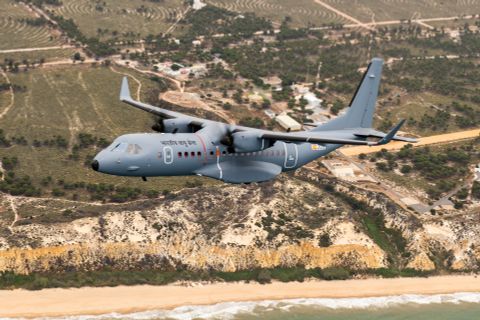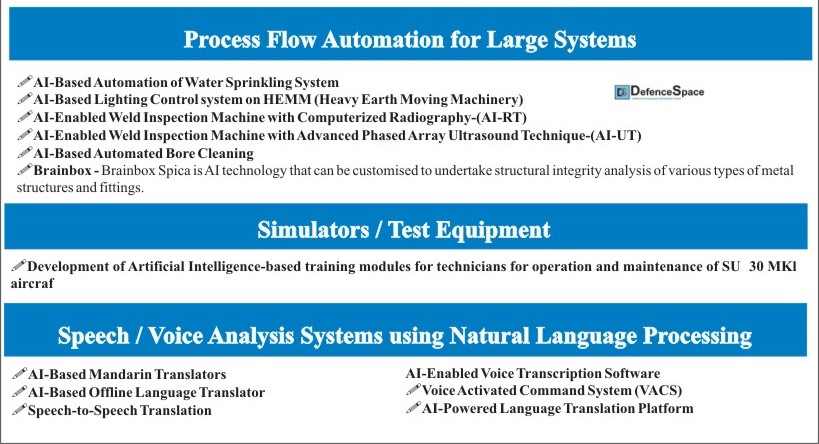BY RITIKA BEHAL
Ever since its inception technology has impacted military conflicts or warfare. Though, it is a known fact that technology alone is not capable of winning any warfare but undeniably it does appear that technology superiority has been the major deciding factor in any warfare or military conflict since ages.
Armed Forces that are better equipped with higher technologies have always and will continue to have an upper hand. Further, technology also has a great deterrent value, hence, even at times can help in averting wars with least damage and costs.
The recent years have witnessed remarkable changes in the global technology environment as a result of acceleration in both the pace of technological advancement as well as the rate of diffusion leading to the development and emergence of military ‘disruptive technologies’ such as Information Warfare (IW), Cloud Computing, Cyber Security, Artificial Intelligence (AI), Robotics, New Undersea Systems, Unmanned Ground Vehicles, deadly UAVs and Blockchain to name a few.
These being more precise and lethal are thus expected to further revolutionize the warfare scenario which will be dominated by information technology. Furthermore, as the speed of technological development accelerates it will revolutionise warfare and competitive edge will rule any kind of warfare. It is believed that the timely and right application of such technologies have even greater potential than nuclear weapons to completely change the balance of power.
Moreover, it needs to be highlighted over here that the future wars will be a ‘Non-Contact War (NCW)’ which will involve minimum manpower or physical contact of Forces and to this aspect development of ‘Airborne Based Disruptive Technologies’ is fast gaining importance.
These technologies basically include Artificial Intelligence, Robotics, Autonomous Unmanned System, Hypersonic, Directed Energy Weapon and Cyber Capabilities to name a few.
Countries such as US, France, Britain, China, and Russia are already pursuing military innovations determined by these technological advancements and have also started integrating them into their aerial weapons and military aviation products and systems.
Airborne Based Disruptive Technologies in the Indian Air Force Context
India faces extrinsic contingencies from its hostile neighbourhood that range from conventional, nuclear to sub-conventional spectrum of conflict as well as intrinsic threats and challenges owing to growing terrorism. Further, as mentioned above we have reached the era of Non-Contact Warfare and thus development of airborne based disruptive technologies has become imperative for India.
The India Air Force (IAF) though has ventured into the field of airborne based disruptive technologies to modernise its forces which range from drone swarms, robotics, directed energy weapons to artificial intelligence, cyber capabilities, cloud computing and big data analysis. However, it still has a long way to go as most of these technologies are under development as of now.
Let us examines some of the airborne based disruptive technologies which have emerged over the recent years and the capability and development of these technologies with regards to the Indian Air Force.
Artificial Intelligence (AI) And Robotics
First in the list is the Artificial Intelligence (AI) and Robotics which is definitely the leading and most popular disruptive technologies of the current era that has and will continue to have major impact on military aviation in the coming years.
The future war systems are likely to be dominated by unmanned systems and to this extent it is gradually becoming an essential part of the rotary and fixed wing unmanned systems as it can provide multiple options for military applications for a strategic, operational and tactical level planning in many of the functions such as Intelligent and autonomous unmanned systems, data analysis, information processing and intelligence analysis, simulation, and training and Defence, offense, and command information warfare etc. and, thus has the power to redefine air power strategy.
Rather, a number of Air Forces of United States, Russia, China, France, and Japan have already invested millions in the development of AI enabled aerial platforms. Some of the Countries are also inducting such platforms and technologies in their inventories as force multipliers.
As for the Indian Air Force, it has also taken some steps in the field of AI enabled platforms and drones. On the indigenous front, the Aeronautical Development Agency (ADA) is working on the Ghatak, a large combat UAV, or UCAV, with stealth technology.
Meanwhile, in the beginning of this year DPSU Hindustan Aeronautics Limited (HAL) has signed a deal with Israel Aerospace Industries (IAI) signed a deal to manufacture the advanced armed Heron TP drones.
Further, IAF has already placed orders for 54 Israeli HAROP attack drones. These will supplement the existing inventory of 110 such drones which are now designated as P-4. These are equipped with electro-optical sensors to loiter over high-value military targets such as surveillance bases and radar stations before exploding them.
Also in pipeline is a joint small, air-launched UAV project of India with US Air Force Research Laboratory and India’s Defence Research and Development Organization is being explored.
However, this is just a beginning as the AI penetration into the Indian Air Force is still miniscule especially considering the advancements made by certain other countries. For example, Russia is very aggressively pushing AI in aerial based platforms and has undertaken development of an autonomous drone which will be able to take off, accomplish its mission and land without human interference though weapons use will, for the time being will require human approval.
Same is the case with China which has a robust focus on AI based airborne disruptive technologies and is developing next generation autonomous vehicles (drones). As for US, it has commenced an Air Combat Evolution (ACE) program that aims to boost war fighter trust in autonomous combat technology by using human-machine combined dog fighting as its preliminary challenge scenario.
ROBOTICS in aerial warfare is another disruptive technology that is finding its way into the Air Forces of many countries. For ex. recently the US Air Force deployed the newly developed four-legged “robot dogs” to defend its perimeters. Undeniably, replacing the convention equipment by robots that are undoubtebly smart and intelligent machines which learn by observation, trial and error not only enhances operational efficiency but are also providing cost effective alternative.
The IAF is also moving ahead in this domain and will soon be procuring robots known as Unexploded Ordnance Handling Robot (UXOR) that can defuse bombs weighing up to 1000 kgs that have not exploded. Indigenously designed by the Defence Research and Development Organisation (DRDO), these robots are monitored from a mobile centre and remove the need for humans to defuse bombs, making them an important tool in times to come.
These robots are controlled remotely from a distance of 2 km. The operator can locate and defuse the explosive by using high pressure water jets.
Again as with the case with AI, the IAF has a long way to go with researching and developing such robotic technologies which definitely will be of great help when inducted in transforming the future of aerial warfare as it will simplify the process of using manpower.
Noteworthy, as per estimations, the Artificial Intelligence and Robotics Industry in India in military domain is currently estimated to be $200-250 Million annually in revenues.
Cyber Capability
With regards to Cyber Capability, the DRDO lab CAIR has developed Network Traffic Analysis (NETRA) which can monitor internet traffic. It can analyse voice traffic passing through software such as Skype, Google Talk and intercept messages with key words attack, bomb, blast, kill and other words in real time.
These would be translated to suitable applications for the Indian Air Force.
Drone Swarm Technology
This is another area which is catching up fast amongst militaries worldwide and has the potential to revolutionize the dynamics of aerial warfare. A swarm/fleet of Drones or Unmanned Aerial Vehicles (UAVs) is a set of aerial robots that work collectively and autonomously make decisions to realize a specific goal based on shared information.
These basically are micro-drones which are of the size and shape of missiles and designed in such a manner to be dropped from aircrafts and carry out reconnaissance purpose in small or large areas.
These are capable enough of working together to overpower any kind of adversaries Noteworthy, every UAV/Drone in a swarm is determined by a definite number of rotors and has the capability to Vertically Hover, Take-Off and Land (VTOL).
As on now countries like US, China, Russia and Britain are leading the race in developing this particular technology. While, Britain is expected to induct “swarm squadrons” in next 2-3 years; the US on the other hand has also been testing interconnected, co-operative drones known as Gremlins.
Image Source: https://www.ndtv.com/
As for INDIA, it has taken commendable steps in this direction to arm IAF with this technology. DPSU Hindustan Aeronautics Limited (HAL) along with a private sector start-up company NewSpace Research and Technologies is developing a swarm drone system known as the ‘Air-Launched Flexible Asset (ALFA-S)’ designed to be launched from fighter aircraft as well as transport aircrafts.
It is expected that the ALFA-S prototype is most likely to be ready in two years. It has also commenced with the process of developing a stealthy Artificial Intelligence enabled munition-loaded semi-autonomous robot known as ‘Wingman’ which would function in a fleet teaming with a fighter jet, providing it with necessary protection and surveillance, thus safeguarding the operator while also broadening the extent of cross-border tasks.
This is the PART-I of the BLOG on ‘THE NEW ERA OF AIRBORNE DISRUPTIVE TECHNOLOGIES’
Stay Tuned for PART-II of this BLOG wherein we will be covering the other ‘Disruptive Technologie’ -
- Directed Energy Weapons (DEWs)
- Countering Unmanned Aerial Vehicle (UAV)/Drone System Technology
- Cyber Capability






2 thoughts on “The New Era of Airborne Based Disruptive Technologies”
Comments are closed.